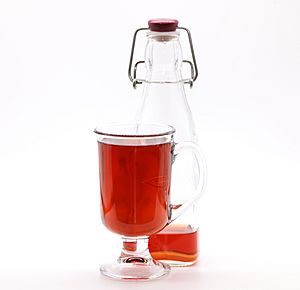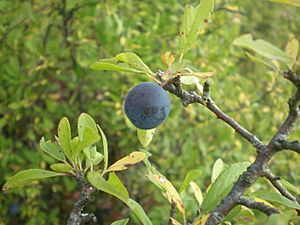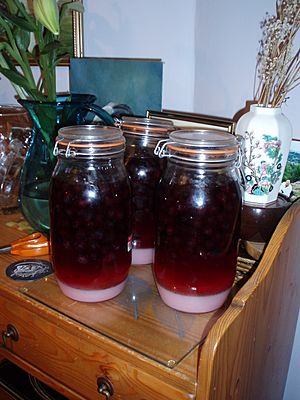Sloe gin facts for kids
Sloe gin is a special red drink from Britain. It is a type of liqueur, which is a sweet alcoholic drink. It is made using gin and sloe berries. Sloes are small, dark fruits that look a bit like tiny plums. They grow on a plant called the blackthorn.
Sloe gin is usually a sweet drink. People traditionally make it by letting sloe berries soak in gin. Most recipes add sugar, but the fruit itself can make the drink sweet as it sits in the alcohol. Sometimes, adding too much sugar can make the drink taste too sweet. It can also stop the berry flavor from mixing well with the gin.
Today, many companies make sloe gin by adding flavors to other types of alcohol. But some still use the old, traditional way. In the United States, people sometimes use similar berries, like beach plums or aronia berries, to make their own versions of sloe gin.
Contents
How Sloe Gin is Made
Sloe gin is made from ripe sloes. Traditionally, people pick these berries after the first frost of winter. This is usually in late October or early November in places like Europe.
Preparing the Sloes
Each sloe berry needs to be pricked. People traditionally use a thorn from the blackthorn bush itself to do this. There's an old story that says you shouldn't prick the sloes with a metal fork unless it's made of silver. A modern way to prepare the berries is to pick them earlier and then freeze them overnight. Freezing them helps to copy the effect of the frost.
Mixing the Ingredients
To make sloe gin, you fill a wide jar about halfway with the pricked sloes. Then, you add about 4 ounces (113 grams) of sugar for every 1 imperial pint (568 milliliters) of sloes. After that, you fill the rest of the jar with gin.
Once everything is in the jar, you seal it tightly. Turn the jar several times to mix everything together. Then, store it in a cool, dark place. For the first two weeks, you should turn the jar every day. After that, turn it once a week. You should let it sit for at least three months.
Finishing the Drink
After a few months, the gin will have turned a beautiful deep ruby red color. You then carefully pour the liquid off. The used sloes can be thrown away, or you can use them in other ways. Some people soak them in white wine or cider. Others use them to make jam, chutney, or even fillings for chocolates.
You can filter the sloe gin to make it clearer. Or, you can carefully pour it into clean bottles, leaving any cloudy bits behind. This helps to make sure the drink is clear and bright.
Variations in Recipes
Recipes for sloe gin can change based on what the maker likes best. You can adjust how sweet it is at the end. But it's important to have enough sugar while the fruit is soaking. This helps to get all the flavor out of the berries.
If the sloes soak for a long time, the alcohol can pull out a flavor from the seeds inside the berries. This gives sloe gin a special almond-like taste. Some recipes use a shorter soaking time and add a tiny bit of almond flavor instead. Another common change is to add a few cloves and a small stick of cinnamon for extra spice.
In North Yorkshire, a company called Masons Gin makes sloe gin differently. They distill the sloe berries with the gin, instead of just soaking them after the gin is made.
Sloe Gin Competitions
There are several fun competitions in the UK for homemade sloe gin.
In January, a sloe gin competition is held in Dorstone, Herefordshire. The winner gets the title "Grand Master of the Sloes." In 2015, 30 different sloe gins were entered. Over 50 judges tasted and scored them based on their color, how clear they were, their taste, and overall quality.
There are also the Sloe Gin Awards in Hebden Bridge, West Yorkshire. These are held every year and give out gold, silver, and bronze awards.
Another competition, the Sloe Gin World Championships, takes place in December at The George Inn in Frant, East Sussex.
Other Berry Drinks
Sloe gin is not the only drink made by soaking berries in alcohol. Many countries have their own similar traditions.
In Germany, a drink called Schlehenlikör is made. It uses sloes, sugar, and sometimes spices soaked in vodka, gin, or rum. A well-known brand of this drink is called Schlehenfeuer, which uses white rum.
In Spain, there is a drink called patxaran. It is made by soaking sloes in an anise-flavored spirit. This creates a light reddish-brown, sweet liquid.
In Italy, a drink called bargnolino is made. It uses sloes with sugar and spices soaked in alcohol. This results in a reddish, sweet drink that is often served chilled.
In Poland, a drink called tarninówka is made. It is an infusion of sloes in vodka or a strong rectified spirit.
Slider is a type of still cider from Devon, UK. It is made by soaking the sloes that have already been used to make sloe gin in cider. Other drinks like sloe whisky and sloe brandy are also made. These are often mixed with ginger beer or ginger ale.




